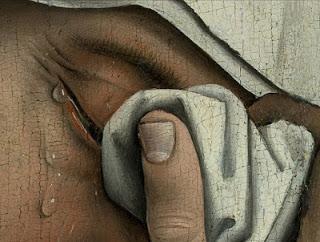
Writing in The Tablet yesterday, Christa Pongratz-Lippit reports on an in-depth study the German Catholic bishops recently commissioned in preparation for the 75th anniversary of World War II. The study, which is entitled in English "German Bishops During World War II," focuses on the role of the German bishops during the Nazi period. I'm highlighting this article as a footnote to my recent discussion of Susan Neiman's book Learning from the Germans.
Pongratz-Lippit reports:
The bishops came to the conclusion that despite individual opposition to Hitler on the part of one or two bishops, the Catholic Church remained part of society during the war. Its patriotic willingness to mobilise the Church's material, personal and mental resources for the war effort remained unbroken until the very end, they say.
The German bishops never protested openly against the Nazi war effort – not in September 1939 when war against Germany was declared – nor at any time afterwards, the bishops point out. "And hardly a voice was raised against the monstrous crimes committed against people who were persecuted because they belonged to an 'alien race', especially the Jews." Individual bishops did protest, for instance against euthanasia, but Catholic soldiers who were confronted with the regime’s rampant violence at the various fronts and sought spiritual help could not turn to their bishops.
The present bishops come to the conclusion that as their predecessors did not clearly oppose the Nazi regime, they bore part of the blame, and they find this "particularly shameful".
At the presentation on 29 April, bishops' conference president Bishop Georg Bätzing explained that while many aspects of the German Church’s behavior during the war had been reappraised, there were two notable gaps, a "memory gap" and a "confession gap". The present German bishops had wanted to fill these two gaps. He and his colleagues had not found this easy as no generation was free of era-specific prejudices. "However, future generations must always face history in order to learn from it", Bätzing underlined.
+++++
The question of what members of the Catholic hierarchy are willing to learn from dismal failures of pastoral and moral leadership is also front and center right now in a statement Anne Barrett Doyle, co-director of Bishop Accountability, has just published on the anniversary of Pope Francis's apostolic letter Vos estis lux mundi.
As Doyle notes, though this document was applauded by church officials and the Catholic media as a bold step forward as the Catholic church (ostensibly) addresses the abuse situation, it appears effectively to have accomplished … nothing at all. We have learned of only one disciplinary action resulting from the apostolic letter: the acceptance of the letter of resignation of Cincinnati bishop Joseph R. Binzer.
The widely publicized investigation of Crookston, Minnesota, bishop Michael Hoeppner, who has admitted in a civil deposition to mishandling priests abusing minors, seems to have gone nowhere, though it was initiated under the rubric of Vos estis. The Vatican appears to be ignoring a request by current St. Paul-Minneapolis archbishop Bernard Hebda to continue the investigation of his deposed and disgraced predecessor John Nienstedt.
And after he was charged by the Vatican to investigate an allegation that Brooklyn Nicholas DiMarzio had abused an altar boy in the 1970s, New York archbishop Cardinal Timothy Dolan took himself off to a radio station and stated about DiMarzio,
I love the guy, he's a good friend, he's never had an accusation against him his whole life.
So much for fair and impartial in-house investigation of serious charges against Catholic officials.
As Anne Barrett Doyle points out, fair and impartial in-house investigation of such charges is well-nigh impossible under the terms of Vos estis, because the document assures that such investigations will occur entirely in-house: clerics will be investigated only by other clerics. She writes,
An end to cover-up is unlikely, given Vos Estis' insularity from start to finish. Few recent papal decrees underscore as clearly the subordinate status of laypeople. Vos Estis requires every decision-maker in the accountability process to be at the level of bishop or higher. No priests, and certainly no laypeople, are permitted to have an authoritative role. Vos Estis even prevented the USCCB from initiating a permanent lay commission to review allegations against bishops.
In a piece praising the new law, canon law expert Kurt Martens observed that Vos Estis re-affirms the hierarchical structure of the Catholic church and so "reminds us what it means to be truly Catholic."
"Independent review boards for bishops go against this fundamental principle of Catholic ecclesiology, and would set our Catholic Church on a slow but sure course towards fragmentation and, ultimately, Protestantism," Martens wrote.
Canon lawyer Edward Peters noted that Vos Estis reflects the fact that "the ecclesiological obstacles to authoritative 'lay involvement' in episcopal disciplinary matters are formidable and, in my view, ultimately insurmountable."
"Christ founded his Church on popes and bishops, and He knew what He was about when He did so; the solution to the clergy sexual abuse, and to the hierarchic failings related to that abuse, must be found within that structure, not a new one," Peters explains.
Pace all the bishops of the world assembled at Vatican II and the flowery language of Vatican II's documents about the people of God, it is "Protestant" to assume that lay Catholics should have a role in governing a church sustained by their gifts and donations. The Catholic church is its hierarchy, and giving laypeople a voice in church decisions and how the church is governed betrays that core Catholic principle which Jesus enunciates clearly in the gospels in … well, I can't quite recall the pertinent passages here. Can you?
How can an institution admit its mistakes and change when it thinks/behaves this way?
It can't.
The graphic: a detail of Rogier van der Weyden's "Descent from the Cross," which is held by the Prado Museum; Google Earth has uploaded this detail to Wikimedia Commons for sharing online.

